Ijraset Journal For Research in Applied Science and Engineering Technology
- Home / Ijraset
- On This Page
- Introduction
- Conclusion
- References
- Copyright
Formulation and Evaluation of Herbal Capsule in Treatment of Migraine
Authors: Bhagyashri Gayke, Anjali Shinde, Pallavi Patharkar, Madhuri Khandgaokar
DOI Link: https://doi.org/10.22214/ijraset.2023.54876
Certificate: View Certificate
Abstract
Introduction
I. INTRODUCTION
Migraine is a collection of perplexing neurological conditions in which the brain and its associated tissues have been implicated as major players during an attack.
Once considered exclusively a disorder of blood vessels, compelling evidence has led to the realization that migraine represents a highly choreographed interaction between major inputs from both the peripheral and central nervous systems. Migraine is a common problem worldwide with significant morbidity and economic impact.
The direct costs of migraine are directly related to the severity of migraine pain and disability, and rise dramatically with prescription medication usage.
Migraine is the commonest cause of recurrent, severe headache. It is experienced at some point by over 20% of women and over 10% men. The tendency to suffer from migraine has a genetic basis, but individual attacks may be triggered by internal or external influences, or simply come by themselves for no apparent reason.
The name ‘migraine’ originally comes from the Greek wordhemicrania, meaning ‘half of the head’, representing one of the most striking features of the condition: that in many cases pain only affects one half of the head.
Equally commonly, however, pain is felt bilaterally, at the front or the back of the head, more rarely in the face, and rarer still in the body (‘migrainous corpalgia’).
The pain is generally throbbing in nature, and typically made worse by any form of movement or even modest exertion. The majority of migraine attacks are severe or at least moderately. [19]
In a cross-sectional study of headache disorders in a population of 1,000persons the epidemiology of migraine with aura (MA) and migraine without aura (MO) was analysed in relation to sex and age distribution, symptomatology and precipitants. The headache disorders were classified on the basis of a clinical interview as well as a physical and a neurological examination using the operational diagnostic criteria of the International Headache Society (IHS).
Lifetime prevalence of MA was 5%, male: female ratio 1:2. Lifetime prevalence ofMO was 8%, M:F ratio 1:7. Women, but not men, were significantly more likely to have MO than MA. Neither MA nor MO showed correlation to age in the studied age interval (25–64 years). Premonitory symptoms occurred in 16% of subjects with MA and in 12% with MO. One or more precipitating factor was present in 61% with MA and in 90% with MO.
In both MA and MO the most conspicuous precipitating factor was stress and mental tension. Visual disturbances were the most common aura phenomenon occurring in 90% of subjects with MA. Aura symptoms of sensory, motor or speech disturbances rarely occurred without coexisting visual disturbances.
The pain phase of MA fulfilled the criteria for MO of the IHS. Headache was, however, less severe and shorter lasting in MA than in MO.
Onset at menarche, menstrual precipitation, menstrual problems, influence of pregnancy and use of oral contraceptives all showed some relationship with the presence of MO and less with MA.
The present findings suggest that MA and MO share the pain phase. Among subjects with MA and MO, 50% and 62%, respectively, had consulted their general practitioner because of migraine.
A. Phases Of Migraine

- Prodrome: The premonitory phase of migraine can begin as early as 3 days before a migraine headache and allows some patients to correctly predict migraine headache up to 12hours before its onset. Common symptoms experienced during this phase, including fatigue, mood changes, food cravings, yawning, muscle tenderness, and photophobia, point to the involvement of the hypothalamus, brainstem, limbic system, and certain cortical areas during the early stages of an attack. Migraine may also display a diurnal periodicity and is commonly triggered by alterations in homeostasis. These findings suggest the involvement of chrono biological mechanisms in migraine pathogenesis and have led to the investigation of the hypothalamus as a potential site of origin of the migraine attack.
- AURA: Approximately one-third of migraine attacks are preceded by aura. The International Classification of Headache Disorders 3rd edition (ICHD-3) defines migraine with aura as recurrent attacks, lasting minutes, of unilateral, fully reversible, visual, sensory or other CNS symptoms that usually develop gradually and are usually followed by headache and associated migraine symptoms. The most prevalent aura symptoms are visual disturbances; however, other common symptoms include sensory, speech/language, and motor disturbances, as well as disruption of higher cortical function.
B. Headache
Approximately one-third of migraine attacks are preceded by aura. The International Classification of Headache Disorders 3rd edition (ICHD-3) defines migraine with aura as recurrent attacks, lasting minutes, of unilateral, fully reversible, visual, sensory or other CNS symptoms that usually develop gradually and are usually followed by headache and associated migraine symptoms. The most prevalent aura symptoms are visual disturbances; however, other common symptoms include sensory, speech/language, and motor disturbances, as well as disruption of higher cortical function.
C. Postdrome
The postdrome stage is also known as a migraine hangover. It starts when the peak pain of the headache has lessened. Migraine can affect the entire body. During the postdrome stage, the resulting pain or discomfort can occur anywhere in the body. Postdrome can last 24 to 48 hours, but it doesn’t affect everyone, and it doesn’t have to occur after each headache. People with migraine can experience the stage differently, and not everyone’s symptoms will be the same. Symptom of postdrome include, fatigue, bodyaches, mental “fogginess”, dehydration depressed moodeuphoric moodtrouble concentrating.
Migraine is a common disabling condition mostly in adult population and is more prevalent in female predominance .Unilateral throbbing type which is from moderate to severe intensity, headache is a common symptom of the migraine though it may be present with varied presentation.

Headache caused by migraine has at least two of the following four characteristics:
- Unilateral location
- Pulsating quality
- Moderate or severe pain intensity
- Causing avoidance of routine physical activity (e.g. walking or climbingstairs). Migraine may be accompanied with nausea, vomiting. Migraine constitute 15 % of primary headache and affects 10-20% of general population. Migraine may be triggered from various factors like; dietary, physical, hormonal and genetic factors. The indirect costs exceed the costs of medical care, however, and work-related disability is the most important determinant of the economic impact of migraine. Migraineurs often miss work (absenteeism) or have reduced productivity at work (presenteeism). The use of herbal therapies is ancient and increasing worldwide. There is a growing body of evidence supporting the efficacy of various “complementary” and alternative medicine approaches in the management of headache disorders. Promising tools to treat migraine patients are herbal products.
D. Trigger Factors Of Migraine
The common trigger factors were emotional stress(79%), sleep disturbance (64%) and dietary factors(44%) sleep and stress were significant trigger factor in patients with migraine with aura, whereas environmental factors were important trigger factors in patients with migraine without aura. Stress, sleep and environmental factors were important trigger factors in women and differed significantly from men.


F. Pathophysiology Of Migraine
There are four phases to a migraine attack: prodrome, aura, headache and postdrome,. The prodrome, caused by hypothalamic activation, is associated with dopaminergic symptoms of yawning, fatigue and polyuria as well as altered food cravings. It can precede the rest of the migraine by hours to days. One-third of patients experience an aura, caused by a spreading wave of cortical depolarisation, which gives the classical phenotypic ‘spreading’ description. Visual auras (photopsias, flickering lines) are most common, experienced by 65–99% of patients who have migraine with aura.6,7 Sensory, motor and speech aura symptoms may also be seen. The trigger for the headache phase is still debated but involves activation of trigeminal afferents that innervate the dura as well as the trigeminal ganglion. Activation of these structures results in a release of vasoactive peptides including calcitonin gene-related peptide (CGRP), substance P, neurokinin A,and pituitary adenylate cyclase-activating peptide (PACAP), causing local vasodilation. The trigeminal ganglion is a key structure as it exists outside the blood–brain barrier and is rich in CGRP and serotonin receptors, making it a therapeutic target. From here, nociceptive signalling is relay to the trigeminocervical complex and through ascending connections to many other areas of the brain, contributing to the cognitive and autonomic symptoms of migraine. Finally, 60–94% of patients have symptoms following the headache, termed the postdromal phase. These include fatigue, mood disturbance and difficulty concentrating, which are likely continued from the prodromal phase. Patients may attribute these symptoms to side effects of their acute therapies; however, a meta-analysis has confirmed theseas features of the disease.
Domestication of plants by man started since the dawn of civilization to meet its basic needs of food, shelter and clothing’s. Besides these requirements nature has provided plants for health care, healing and other comforts1.
With the emerging interest in the world to adopt and study the traditional system and to exploit their potentials based on different health care systems, the evaluation of the rich heritage of the traditional medicine is essential. Now a days, herbal extracts, and herbal powders are used in the preparations to enhance beauty and increase the attractiveness of the person. These herbal preparations are used as sunburn, complexion brighter, hair remover etc. Herbal cosmetics can be classified on the basis of Dosage Form like- cream, powder, soaps, solutions etc Herbal preparations are also found to be useful drugs in treatment of various disorders.
G. Advantages of Herbal Medicine
- Herbal medicine have long history of use and better patient tolerance as well as acceptance.
- Medicinal plants have a renewable source, which is our only hope for sustainable supplies of cheaper medicines for the world growing population.
- Availability of medicinal plants is not a problem especially in developing countries like India having rich agro-climatic, cultural and ethnic biodiversity.
- The cultivation and processing of medicinal herbs and herbal products is environmental friendly.
- Prolong and apparently uneventful use of herbal medicines may offer testimony of their safety and efficacy both in crude form and as a pure chemical upon which modern Throughout the world, herbal medicine has provided many of the most potent medicines to the vast arsenal of drugs available to modern medical science, medicines arestructured.
Natural Herbal Products are becoming more popular across world. Plants have been found to be useful for treating various ailments in humans and animals, and people tend to use natural produced substances due to their psychological feeling that natural product is safer.
Following crude drugs are used to formulate the herbal capsule for treatmentin migraine.
- Emblica officinalis Common name – Amla Family - Phyllanthaceae
Use - In migraine Amla control internal secretion of chemical andreduces chances of
blood pressure which is a major cause of migraine.
- Zingiber officinale Common name – Ginger Family Zingiberaceae
Use - The chemical compounds in this oil which include gingerols and shogaols have anti-inflammatory and pain-relieving effects and are also effective at treating nausea and vomiting, two symptomsassociated with migraine attacks.
- Withania somnifera
Common name - Indian ginseng Family – Solanaceae
Use - Ashwagandha may directly reduce migraines by controllingstres.
- Glycyrrhiza glabra
Common name – Liqourice, jethmadh Family – Fabaceae
Use - It has its effectiveness in stress relieving and memory enhancing.
II. LITERATURE SURVEY
- Narendra singh, et al., (2011)
Withania somnifera (Ashawagandha) is very revered herb of the Indian Ayurvedic system of medicine as a Rasayana (tonic). It is used for various kinds of disease processes and specially as a nervine tonic. Considering these facts many scientific studies were carried out and its adaptogenic / anti-stress activities were studied in detail. In experimental models it increases the stamina of rats during swimming endurance test and prevented adrenal gland changes of ascorbic acid and cortisol content produce by swimming stress.
2. Shashikant M Prajapati, et al., (2013)
Glycyrrhiza glabra Linn. commonly known as Licorice/Liquorice, Sweet wood, Mulahatti and Yashtimadhu. The present review study is an attempt to provide reported information on its phyto-constituents and pharmacological activities.
3. Daniela Pietrobon, et al., (2013)
Migraine is a collection of perplexing neurological conditions in which the brain and its associated tissues have been implicated as major players during an attack. This review focuses on emerging concepts that drive the science of migraine in both a mechanistic direction and a therapeutic direction.
4. Neeru Bhatt, et al., (2013)
Ginger is a rhizomatous plant and has been used as a spice and medicine in theIndian subcontinent since ancient times. The herb serves as a stimulant and carminative and is used in dyspepsia and colic. It is known to have blood thinning and cholesterol lowering properties, due to which it is used in treatingheart diseases. The major phenolic compounds and essential oils act as potent antioxidant and exhibit free radical scavenging properties.
5. Sankaran Mirunalini, et al., (2013)
Medicinal plants are natural gift to human lives to promote disease free healthy life. Phyllanthus emblica, commonly known as amla is widely distributed in tropical and subtropical areas and has therapeutic potential against deleterious diseases. Earlier it becomes a notable fruit for its rich amount of vitamin C, polyphenols such as tannins, gallic acid, ellagic acid, flavonoids like quercetin and rutin.
6. D’Andrea, et al., (2014)
A miscellaneous of recreational drugs and other herbal remedies have been supposed to have a role in headache treatment but quality of clinical studies in this field is low and inconclusive. Further research is warranted in this area.
7. Nisha, et al., (2015)
Migraine is described as Ardhaavabhedhaka in Ayurvedic classics. Migraine isthe second most common cause of headache. In Ayurvedic Classics various procedures had been explained for treating Migraine. This article presents some conceptual approaches of ayurveda for the treatment of migraine.
8. Bhupendra Shah, et al., (2017)
Migraine is a common disabling condition mostly in adult population and shows female predominance .Unilateral throbbing type moderate to severe intensity headache is a common manifestation of the migraine though it may present with varied presentation. This article reviews the path physiology, diagnosis and evidence based approach for management of migraine.
9. Purnendu Panda, et al., (2017)
Conventional solid dosage forms include powders, granules, capsules, andtablets. Drugs (which are chemicals) are in general more stable in solid state than in liquid state. For this reason, poorly stable drugs are usually prepared in solid dosage forms. In this chapter, we will examine two solid dosage forms, powders.
10. Jacob Olalekan Arawande, et al., (2018)
The percentage yield of each extract in each of the solvent was calculated and each extract was qualitatively screened for flavonoids, tannin, reducing sugar, volatile oil, resin, chalcone, balsam, amino acid, acid test, phlobatannin, saponins and vitamin C.
11. Aminu Saleh Ahmad, et al., (2020)
This work reviews and comparatively analyzes the herbal and allopathic treatments to cure the problems in health care. It suggests the adoption of the concept of integrative medication and health care that connects mainstream allopathic medical treatment and herbal therapies and select the best, scientifically validated therapies out of the systems.
12. Deborah I. Friedman, et al.,
Migraineurs often describe environmental triggers of their headaches, such as barometric pressure change, bright sunlight, flickering lights, air quality, and odors. Environmental aspects of indoor space and workplaces are also implicated in migraine experience. This article addresses commonly mentioned environmental triggers with a discussion of their pathophysiology and proposed preventive measures.
13. Pushpendra Kumar Jain,et al.,(2016)
EO is famous ayurvedic herb (the name means sour in Sanskrit) is likely one of the most useful drug treatments within the Indian pharmacopoeia, and is considered to be one of the most strongest uvenatives (Rasayana), particularly for the blood, bones, liver, and heart. It is an exceptionally rich source of vitamin C containing 30 times the amount found in oranges. It is one of the oldest oriental medicines mentioned in Ayurveda as potential remedy for various ailments. EO (Amla) is widely used in the ayurvedic medicines and believed to increase defense or immune power against diseases.
14. Jason C Ray,et al.,(2021)
Migraine is a common neurological disorder, affecting over one billion people worldwide. The World Health Organization Global Burden of Disease study ranked migraine as the second leading cause of disability.1 Every year, 2.5% of patients with episodic migraine progress to chronic migraine, with associated impacts on quality of life and health care use. The key modifiable risk factors are effective preventive medication, avoidance of acute medication overuse, obesity, stress, depression and anxiety
A. Objective
- To formulate and evaluate such a herbal powder that is useful in treating migraine.
- It also reduces the frequency of migraine attacks.
- To formulate an easy to administer product.
- Helps to tackle nausea and vomiting caused during migraine attacks. • Improve hormonal balance.
B. Plan of Work
|
Literature Survey. |
|
Selection of plant material. |
|
Procedure Crude Drugs |
|
Evaluation of plant material. |
|
Evaluation of formed product. |
|
Result and conclusion. |
C Drug Profile
1) Emblica officinal
- Kingdom Plantae (Plants)
- Subkingdom- Tracheobionta
- Superdivision- Spermatophyt
- Division-Angiospermae
- Class-Dicotyledone
- Subclass- Rosidae Order-Geraniales
- Family-Euphorbiaceae
- Genus-Emblica
- Species- Officinali Geartn
- Part used-Seeds
a) Use - In migraine Amla control internal secretion of chemical and reduces chances of blood pressure which is a major cause of migraine.
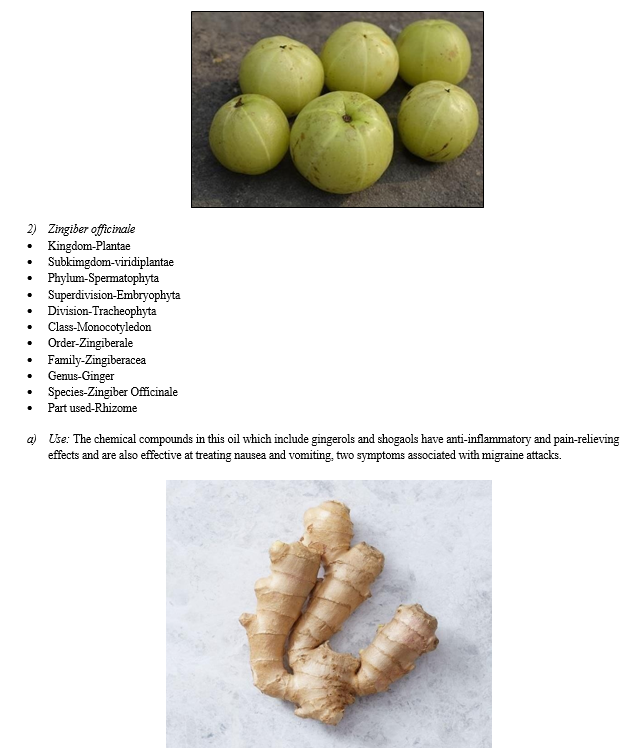
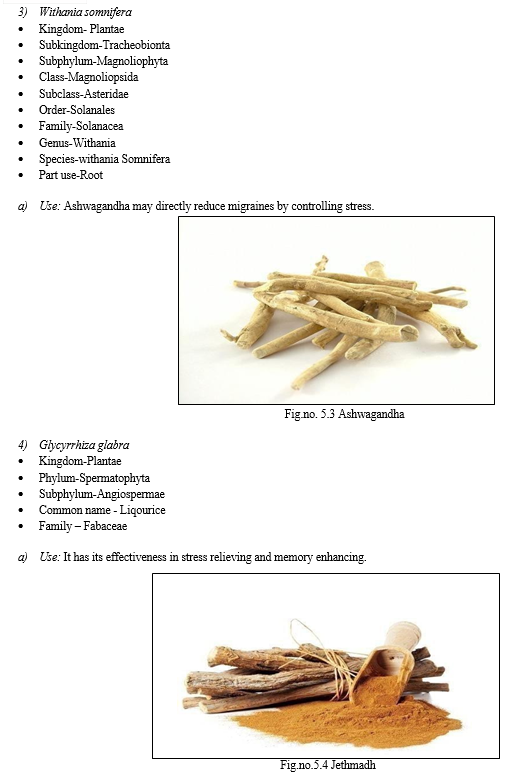

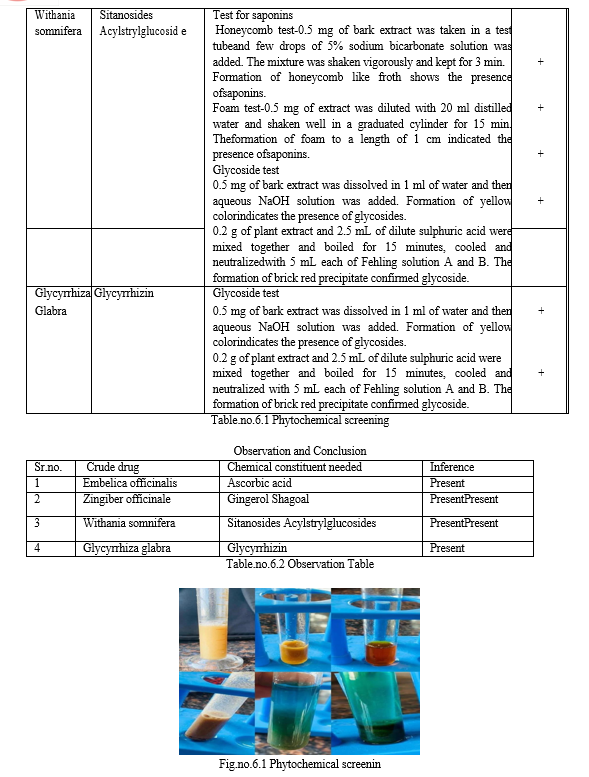

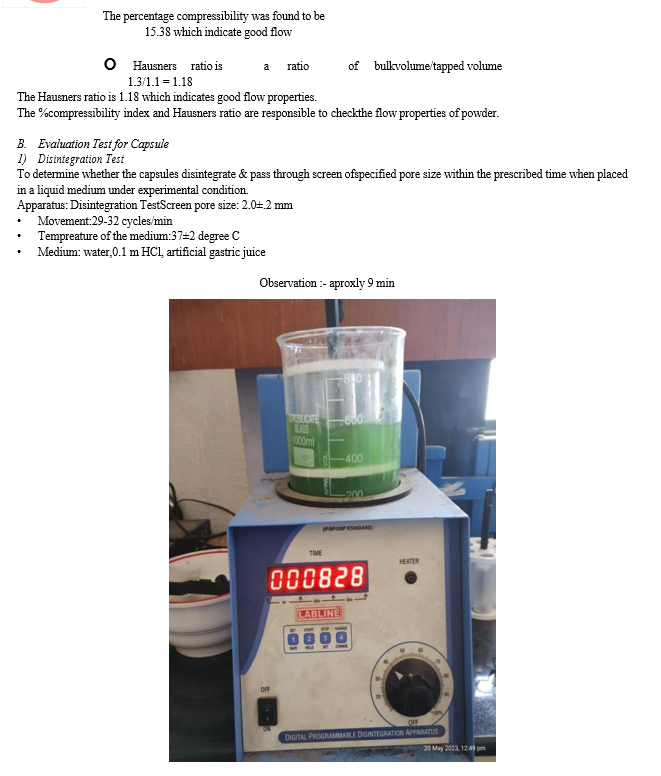
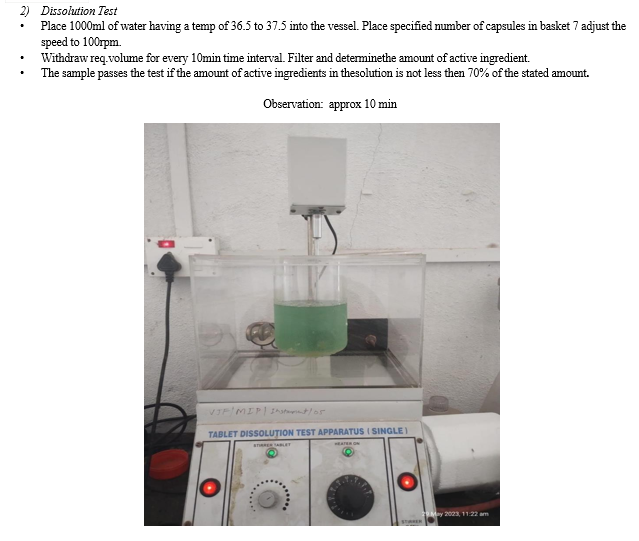
Conclusion
The Herbal capsule made up of Amla, Ashwagandha, Yashtimadhu and Ginger powders mixed together is formulated to manage and treat various symptoms associated with migraine. Phytochemical screening tests and assay were also performed to check the presence of the required chemical constituents. The tests showed positive result for thepresence of the chemical constituent
References
[1] Rasmussen BK, Olesen J. Migraine With Aura and Migraine Without Aura: An Epidemiological Study. Cephalalgia. 12(4):221-228, 1992 [2] R.B. Lipton, M.E. Bigal, M. Diamond, F. Freitag, M.L. Reed, W.F. Stewart. Migraine prevalence, disease burden, and the need for preventive therapy, Neurology by AAN Enterprises, Inc, 2007 [3] Kadambari Tomar, Neeraj k. Sethiya, Vijendra Singh. Preparation andcharachterization of some polyherbal formulation for evaluation of hair colorant effects, Int. J Pharmacy and Pharm. Sci. 1(2), oct-dec 2009 [4] Narendra Singh, Mohit Bhalla, Prashanti De Jager, Marilena Gilca. An Overview on Ashwagandha: A Rasayana (Rejuvenator) of Ayurveda, Afr Traditi Complement Altern Med, 8(5), july 2011 [5] Hussein Farhan, Hassan Rammal, Akram Hijazi, Bassam Badran. Preliminary Phytochemical Screening and Extraction of Polyphenol From Stems and Leaves of a Lebanese Plant Malva Marviflora L., International Journal of Current Pharmaceutical Research, 4( 1), 2012 [6] Kumar Sumit, Swarankar Vivek, Sharma Sujata, Baldi Ashish. HerbalCosmetics: Used for Skin And Hair, Inventi Rapid: cosmeceuticals, vol 2012, (4). [7] Daniela Pietrobon1,2 and Michael A. Moskowitz3. Pathophysiology of Migraine, Annual Review of Physiology ,Vol. 75:365-391 (Volume publication date February 2013) [8] Neeru Bhatt, Mostafa I. Waly, Mohamed M Essa, and Amanat Ali. Ginger: A functional herb(2013). [9] Shashikant M Prajapati , Bhupesh R Patel. Phyto-PharmacologicalFunctional Herb, J of Food and Medicine, 71(51), 2013 Perspective of Yashtimadhu (Glycyrrhiza Glabra LINN.) – A Review, International Journal of Pharmaceutical & Biological Archives, 4(5): 833 – 841, May 2013 [10] Sankaran Mirunalini, Velusamy Vaithiyanathan and Mani Krishnaveni. Amla: A novel ayurvedic herb as a functional food for health benefits”- a mini review [11] International Journal of Pharmacy and Pharmaceutical Sciences, Vol 5, Suppl 1, 2013 [12] G. D’Andrea, S. Cevoli, D. Cologno. Herbal therapy in migraine. Neurological Sciences, 35, pages135–140 (2014) [13] Lokesh. Versatile Ayurvedic Approaches for Treating Migraine: A Review Nisha, Journal of Innovations in Pharmaceuticals and BiologicalSciences, 2(1), 68-71, 2015. [14] Bhupendra Shah and Dipesh Raj Pandey. Migraine: Review, European Journal of Biomedical and Pharmaceutical sciences, 4 (4), 2017 [15] Purnendu Panda,Dighe Dattatray, , Sanjib kumar Das , M.M.Rao. A Review on Pharmaceutical and Therapeutical Uses of Churna (powder) in Ayurveda, International Ayurvedic Medical Journal, 5(11), November 2017. [16] Jacob Olalekan Arawande, Akinyinka Akinnusotu, Jacob Olabode Alademeyin. Extractive Value and Phytochemical Screening of Ginger (zingiber officinale) and Turmeric (curcuma longa) Using Different Solvents, International Journal of Traditional and Natural Medicines, 8(1) 13-22, 2018 [17] David w. Dodwick. A Phase-by-Phase Review of Migraine Pathophysiology, J Head and Face Pain, 2018 [18] Sahithi AS, Muthu T, Saraswathy R. Migraine: Update and Future Perspectives. Int J Nutr Pharmacol Neurol Dis ,10:179-87, 2020 [19] Aminu Saleh Ahmad, Ruchi Sharma. Comparitive Analysis of Herbal and Allopathic Treatment systems, European Journal of Molecular & Clinical Medicine Volume 07, Issue 07, 2020 [20] Deborah I. Friedman, Timothy De Ver Dye. Migraine and the Environment. The Journal of Head And Face, 49(6) [21] Adrian L. Lopresti,Stephen J. Smith,Peter D. Drummond.Herbal treatments for migraine: A systematic review of randomised-controlledstudies. Phytotherapy Research Journal, 34(10) [22] Bhupendra Shah* and Dipesh Raj Pandey .European Journal of Biomedical And Pharmaceutical science: Migraine volume 04, Issued 2017. [23] Mark W. Weatherall .The diagnosis and treatment of chronic migraine,A Review Volume 6,issue 2015 [24] Pescador Ruschel MA, De Jesus O. Migraine Headache. Publishing 2022 [25] Jason C Ray,: The state of migraine, An update on current and emerging treatments, vol50, December2021
Copyright
Copyright © 2023 Bhagyashri Gayke, Anjali Shinde, Pallavi Patharkar, Madhuri Khandgaokar. This is an open access article distributed under the Creative Commons Attribution License, which permits unrestricted use, distribution, and reproduction in any medium, provided the original work is properly cited.

Download Paper
Paper Id : IJRASET54876
Publish Date : 2023-07-20
ISSN : 2321-9653
Publisher Name : IJRASET
DOI Link : Click Here
 Submit Paper Online
Submit Paper Online

